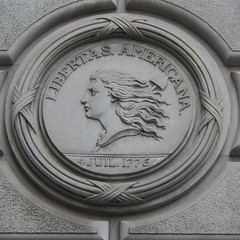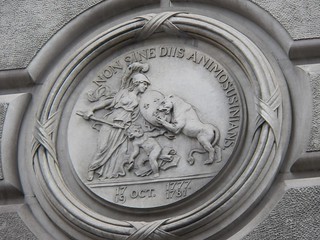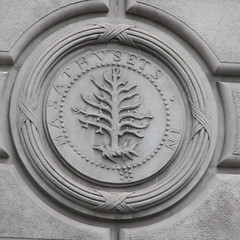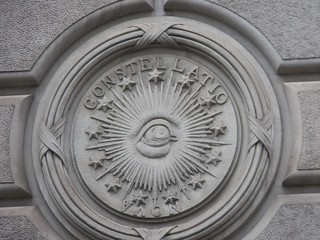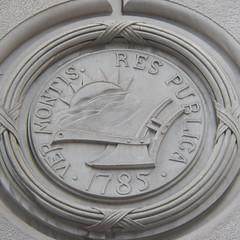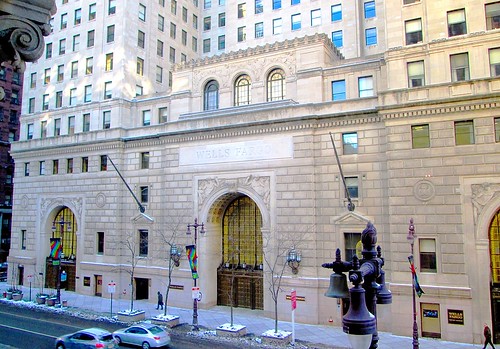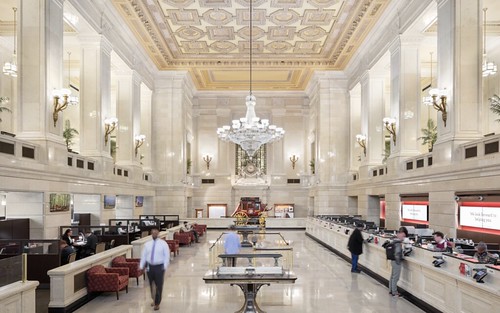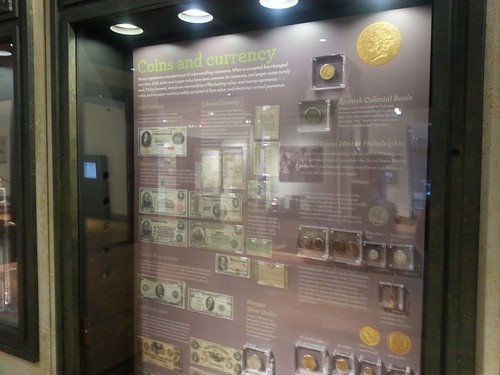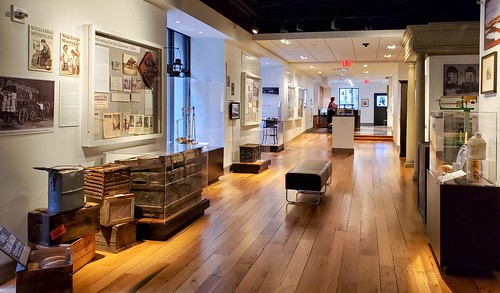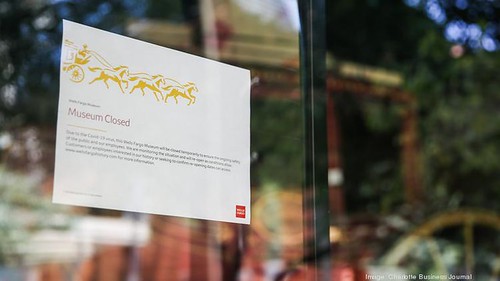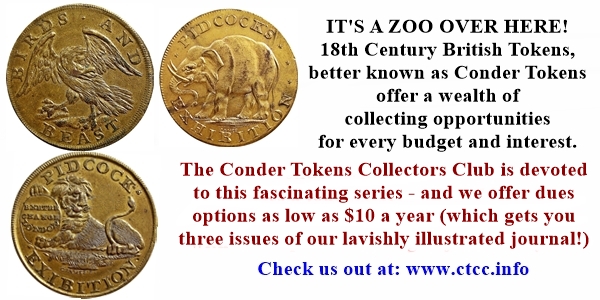
PREV ARTICLE
NEXT ARTICLE
FULL ISSUE
PREV FULL ISSUE
V25 2022 INDEX E-SYLUM ARCHIVE PHILADELPHIA BANK BUILDING COIN SCULPTURESRegarding last week's image of a Fugio Cent on a Philadelphia bank building, Craig McDonald writes: "The image of the Fugio obverse on the bank building in Philadelphia brought back some memories.
"At the 2017 Early American Coppers Convention held just down the street from the bank building, several of us went to lunch and walked by the building. Someone pointed out the artwork. I snapped a few pictures from street level." Craig provided several photos. These are great! Thanks. -Editor Dr. Google helped me find some more information on the building itself. -Editor The Wells Fargo Building, originally the Fidelity-Philadelphia Trust Company Building, is a skyscraper in Center City, Philadelphia, Pennsylvania, United States. Designed in the Beaux-Arts style by the architectural firm Simon & Simon, the building was erected for the Fidelity-Philadelphia Trust Co. in 1928. The 29-story high-rise is listed on the National Register of Historic Places. At street level, three arched entranceways line Broad Street. The central arch is slightly larger than the others to indicate the entrance to the main banking hall. Carved into the facade above the center arch is the building's name. Inside the arches and above the doorways are windows designed by d'Ascenzo Studios. Leaded panes of glass of various shades of amber are surrounded by a Renaissance-style border. Below the windows are bronze doors, each with 24 high-relief panels depicting the history of commerce and civilization. Bas-relief figures decorate each of the arches' spandrels. A male figure with a hammer representing industry and a female figure with a beehive representing thrift decorate the center arch. The arch closest to Sansom Street is decorated by two figures with cornucopias to represent abundance. The arch nearer to Walnut Street is decorated by a painter and a sculptor to represent art. Next to the two smaller archways are carved medallions, one flanking each spandrel. The medallions closest to Sansom Street represent early American coins, a Pine Tree coin from Massachusetts and Grandi Copper coin from Connecticut. The medallions closest to the Walnut Street side represent the first American coin issued by Congress and the Eye Coin from Vermont. Two medallions on the Walnut Street side depict both sides of the Lafayette Medal. Only one medallion decorates the Samson Street side, depicting another early coin from Vermont. The lobby holds a branch of the Wells Fargo History Museum; its exhibits include a stagecoach, telegraph equipment, historic clothing and currency. Newspaper reporters aren't the best with numismatic facts. It's the Granby copper and the Libertas Americana medal for starters. But we should be glad the roundels got mentioned at all. -Editor
To read the complete article, see:
The interior includes a 2 1/2-story banking hall with cream-colored terrazzo marble and a five-tier, 1.25-ton chandelier, that measures 11 feet high by 11 feet wide. One of the largest made in the U.S., it contains 10,000 hand-cut and polished, Austrian and West German crystals. The bank branch also includes a 25 foot tall stained-glass window, with images of Independence Hall, George Washington's Farewell Address to Congress, William Penn's treaty with the Indians, the signing of the Declaration of Independence, Benjamin Franklin's printing office and Betsy Ross displaying the United States flag.
To read the complete article, see:
Upon acquiring the historic home of the Fidelity-Philadelphia Trust Company, Wells Fargo set up the Wells Fargo History Museum in the lobby of the building. The Museum connects the history of Wells Fargo and the gold rush with the Philadelphia Mint and influential Philadelphia banks of the era. In the Wells Fargo History Museum, you can learn about the important history of the financial institutions of Philadelphia and how they relate to the history of Wells Fargo. Inside the Museum are a number of exhibits and artifacts including an authentic Concord city-style stagecoach.
To read the complete article, see:
Behind the facade at Broad and Walnut is a miniature museum filled with artifacts from 19th century American banking and commerce.
Set just off the lobby of the historic skyscraper, which played a starring role in the 1983 Dan Aykroyd-Eddie Murphy comedy
Well that's sad. I was at an ANA convention in downtown Philadelphia pre-pandemic, and I didn't know the Wells Fargo museum existed. Was there a convention tour? EAC missed it, too, but at least some attendees saw the outside. Have any of our readers visited? -Editor
To read the complete article, see:
As Joni Mitchell wrote in "Big Yellow Taxi", "You don't know what you've got 'til it's gone". The museum didn't survive the pandemic. Sad squared. -Editor
To read the complete article, see:
To read the earlier E-Sylum article, see:
Wayne Homren, Editor The Numismatic Bibliomania Society is a non-profit organization promoting numismatic literature. See our web site at coinbooks.org. To submit items for publication in The E-Sylum, write to the Editor at this address: whomren@gmail.com To subscribe go to: https://my.binhost.com/lists/listinfo/esylum All Rights Reserved. NBS Home Page Contact the NBS webmaster 
|

